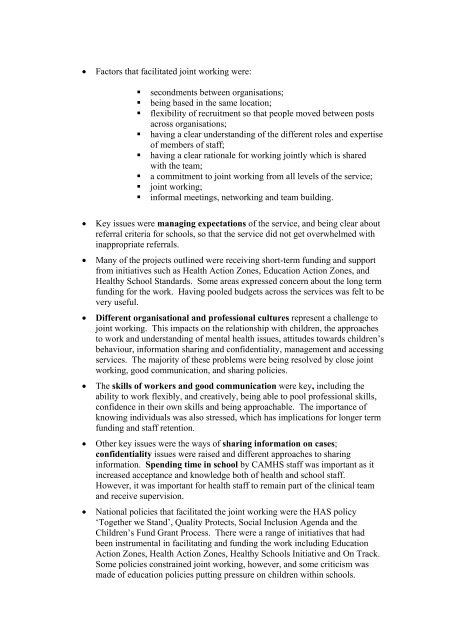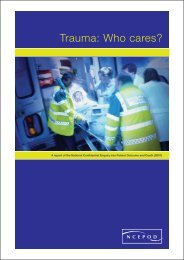(CAMHS) and Schools - London Health Programmes
(CAMHS) and Schools - London Health Programmes
(CAMHS) and Schools - London Health Programmes
You also want an ePaper? Increase the reach of your titles
YUMPU automatically turns print PDFs into web optimized ePapers that Google loves.
• Factors that facilitated joint working were:<br />
• secondments between organisations;<br />
• being based in the same location;<br />
• flexibility of recruitment so that people moved between posts<br />
across organisations;<br />
• having a clear underst<strong>and</strong>ing of the different roles <strong>and</strong> expertise<br />
of members of staff;<br />
• having a clear rationale for working jointly which is shared<br />
with the team;<br />
• a commitment to joint working from all levels of the service;<br />
• joint working;<br />
• informal meetings, networking <strong>and</strong> team building.<br />
• Key issues were managing expectations of the service, <strong>and</strong> being clear about<br />
referral criteria for schools, so that the service did not get overwhelmed with<br />
inappropriate referrals.<br />
• Many of the projects outlined were receiving short-term funding <strong>and</strong> support<br />
from initiatives such as <strong>Health</strong> Action Zones, Education Action Zones, <strong>and</strong><br />
<strong>Health</strong>y School St<strong>and</strong>ards. Some areas expressed concern about the long term<br />
funding for the work. Having pooled budgets across the services was felt to be<br />
very useful.<br />
• Different organisational <strong>and</strong> professional cultures represent a challenge to<br />
joint working. This impacts on the relationship with children, the approaches<br />
to work <strong>and</strong> underst<strong>and</strong>ing of mental health issues, attitudes towards children’s<br />
behaviour, information sharing <strong>and</strong> confidentiality, management <strong>and</strong> accessing<br />
services. The majority of these problems were being resolved by close joint<br />
working, good communication, <strong>and</strong> sharing policies.<br />
• The skills of workers <strong>and</strong> good communication were key, including the<br />
ability to work flexibly, <strong>and</strong> creatively, being able to pool professional skills,<br />
confidence in their own skills <strong>and</strong> being approachable. The importance of<br />
knowing individuals was also stressed, which has implications for longer term<br />
funding <strong>and</strong> staff retention.<br />
• Other key issues were the ways of sharing information on cases;<br />
confidentiality issues were raised <strong>and</strong> different approaches to sharing<br />
information. Spending time in school by <strong>CAMHS</strong> staff was important as it<br />
increased acceptance <strong>and</strong> knowledge both of health <strong>and</strong> school staff.<br />
However, it was important for health staff to remain part of the clinical team<br />
<strong>and</strong> receive supervision.<br />
• National policies that facilitated the joint working were the HAS policy<br />
‘Together we St<strong>and</strong>’, Quality Protects, Social Inclusion Agenda <strong>and</strong> the<br />
Children’s Fund Grant Process. There were a range of initiatives that had<br />
been instrumental in facilitating <strong>and</strong> funding the work including Education<br />
Action Zones, <strong>Health</strong> Action Zones, <strong>Health</strong>y <strong>Schools</strong> Initiative <strong>and</strong> On Track.<br />
Some policies constrained joint working, however, <strong>and</strong> some criticism was<br />
made of education policies putting pressure on children within schools.

















